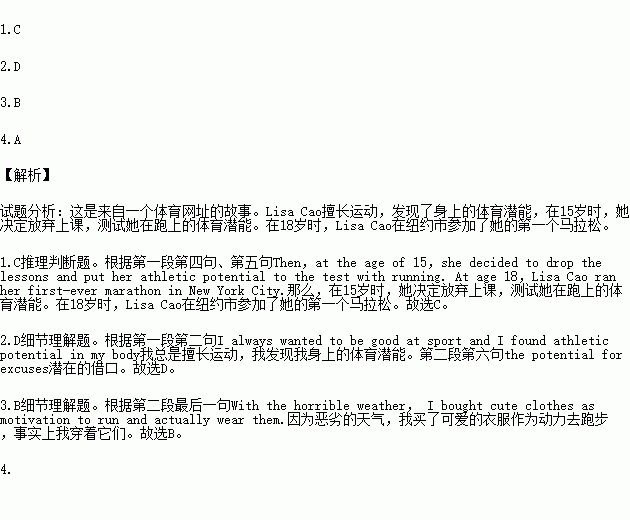题目内容
Like lots of other girls and boys,when Lisa Cao was a kid,she used to watch the Olympics. “I always wanted to be good at sport and I found athletic potential in my body”, the New York City citizen tells her friends. But there was no sport available so she took up piano lessons. Then,at the age of 15,she decided to drop the lessons and put her athletic potential to the test with running. At age 18,Lisa Cao ran her first-ever marathon in New York City. And now,the 27-year-old has 54 marathons 26. miles) and ultramarathons (100 miles) under her belt.
What does it take to be an ultramarathoner? A lot of devotion,even when difficulties occur sometimes. “Making time for running is really hard when life is so busy,” she says. “There’s a big work-life balance that I have to keep. I have to wake up earlier on the weekends. And oh,the potential for excuses! With NYC’s wild winters as of late,it’s easy to blame the weather,roll over in bed and put off a solid run. I have a fix for this,though,” she says. “Cute clothes. With the horrible weather, I bought cute clothes as motivation to run and actually wear them. ”
While she’s training during low season in the winter,Lisa Cao tries to run a “base” of 20 to 30 miles per week to stay prepared. During high season in the spring and summer,she’ll run around 30 to 40 miles,but she also gets a lot of quality miles from her races.
1.When did Lisa Cao run her first marathon?
A. At the age of 27.
B. When she was 15 years old.
C. Three years after she began running.
D. Nine years after she dropped her piano lessons.
2.What made Lisa Cao have the desire of joining in sports?
A.Being different from other kids of her age.
B.Wanting to join in the Olympics.
C. Having no interest in piano lessons.
D. Having athletic potential.
3.Why does Lisa Cao buy beautiful clothes in terrible weather?
A. To have a better sleep.
B. To motivate herself to keep running.
C. To protect herself from any harm.
D. To save time for further training.
4.Where is the text probably taken from?
A. A sport website
B. A science book.
C. A college poster
D. A football magazine.
 阅读快车系列答案
阅读快车系列答案
